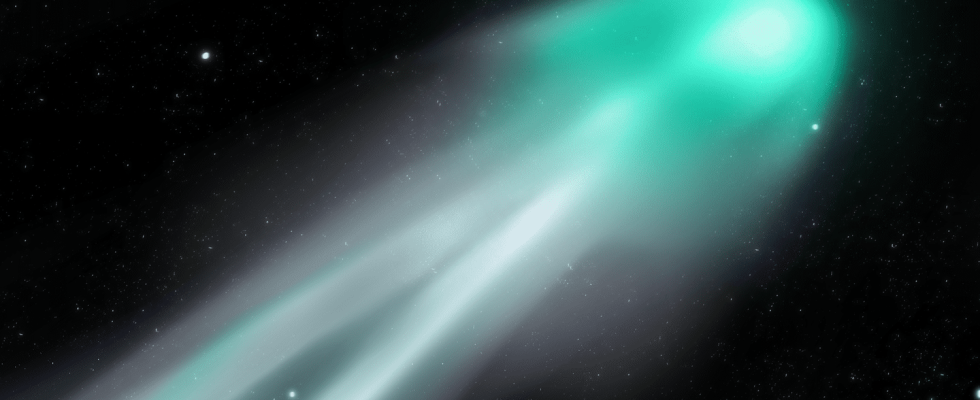
Published
Reading time: 5 min

Comet 12P/Pons-Brooks, its scholarly name, only appears in the vicinity of the Earth every seventy-one years.
It is not as spectacular as Hale-Bopp’s comet, which shone in the sky for several months in 1997, but it is sure to amaze. The “devil’s comet”, also called 12P/Pons-Brooks, is visible in our latitudes at the start of spring. Franceinfo presents this distant visitor who we only see every seventy-one years. This icy ball, which like all comets is a vestige of our solar system, should be easily observable from March 28 and until mid-April in the early evening, with simple binoculars.
It was discovered by a Frenchman
Comet 12P/Pons-Brooks was discovered by Jean-Louis Pons in 1812 at the Marseille observatory. The man who had been hired as a janitor in the establishment ended up becoming an astronomer, then deputy director of the institution. Internationally recognized, Jean-Louis Pons was one of the most prolific comet discoverers in history.
Above all, the object observed by Jean-Louis Pons in 1812 was found independently by the American William Brooks in 1883, seventy-one years later. He then took the names of his two discoverers, even if, in reality, the first signs of observation of this “devil’s comet” date back to the 14th century, in China and Japan.
It has a larger than average core
Comets have on average a nucleus 10 km in diameter. According to the latest estimates, that of 12P/Pons-Brooks measures 30 km, notes Nicolas Biver, astronomer at the Paris Observatory and president of the comet commission of the French Astronomical Society. Thirty kilometers is also twice as long as Halley’s famous comet, he points out.
“It must be one of the ten largest comets currently known.”
Nicolas Biver, astronomerat franceinfo
The tail of the comet “is not hyperextended” but still takes place over some 50 million kilometers, i.e. “one third of the distance from the Earth to the Sun”notes Nicolas Biver.
She owes her nickname to two horns
The Devil’s Comet is known for its bursts. It is in fact the scene of explosions, which cause its brightness to vary significantly, or change the shape of his “hair”. This is what happened at the end of 2023 when she found herself with two streaks or strands. Some people thought they saw two horns, which earned it the nickname “devil’s comet.” But sensitivities are different and some have instead identified the silhouette of the Millenium Falcon, the famous ship from the saga. Star Wars.
What are these bursts due to? “We never really know. It’s specific to each comet. It’s linked to their unique characteristicsreplies Nicolas Biver. We should go and see there.” “However, we have hypotheseshe says. Is an area richer in ice periodically more exposed to the Sun, causing these puffs of dust? This happens almost every fortnight.. Or is it related to the shape of the nucleus? If it is perfectly spherical, nothing special happens. If it has a very uneven shape, it is possible that pieces will break off, causing these bursts of light.”
She has green hair
Beyond pareidolia, that is to say what the shape of the comet can evoke, 12P/Pons-Brooks delights photographers who scrutinize its green color.
“It is something well known, linked to the presence of certain compounds in the atmosphere of the comet, notably dicarbonintroduced Nicolas Biver. It’s not really a molecule: it has already been broken by solar radiation.” During this process an element is created “which probably comes from acetylene”. But the latter is green in color. “This is what we see when we weld with acetylene”underlines the astronomer.
It is visible next to Jupiter
After a window of visibility at the beginning of March, the Devil’s Comet should again be easily observable between March 28 and until mid-April, according to Nicolas Biver. To put all the chances on your side, go to a place away from light pollution, far from cities. Clear skies are obviously essential.
“You need a very clear west/northwest horizon”, because at nightfall, the comet should not be very high in the sky, insists Nicolas Viber. To see it, you will first have to find Jupiter, the largest planet in the solar system, easily visible to the naked eye. The comet will then be right next to Jupiter. Point at this planet by extending your arm, then close your hand: the comet should be a fist away from Jupiter, on the right.
“With binoculars – glasses of 5 cm in diameter are necessary – you will be able to see a small spot and possibly a piece of the comet’s tail”, assures the astronomer. The Devil’s Comet will then pass towards the southern hemisphere from April 21. After that, we will have to wait until the year 2095 to see her again.
